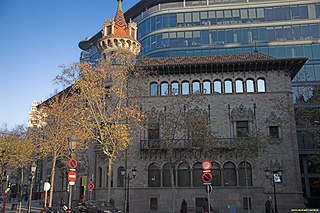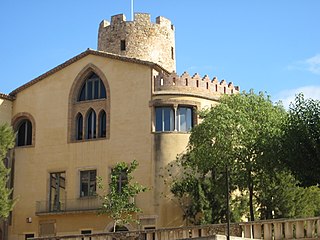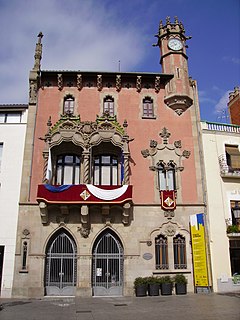
The Barcelona Provincial Council Local Museum Network, also known as Catalonia’s Biggest Museum, is a tool for support and collaboration from and for the museums of the province, which makes available to municipalities a series of services and actions aimed at improving, through the provision of direct services and research into viable formulas for supramunicipal cooperation, the management, conservation and dissemination of heritage and the museum facilities of the towns of Barcelona province. It is managed from the Cultural Heritage Office, which in turn depends on the Department of Knowledge and New Technologies of Barcelona Provincial Council.

The Cardadeu Tomàs Balvey Museum-Archive, in Cardedeu, Vallès Oriental, is organised around the legacy of Tomàs Balvey i Bas (1865–1954), the last of a line of apothecaries in Cardedeu. The theme of the museum is based on the pharmacy and its pharmacist, focusing on the world of illness, remedies and health. The Museum-Archive is part of the Barcelona Provincial Council Local Museum Network and of the Catalan Pharmacy Museum Network.
The Museu de la Pagesia, in Castellbisbal, Vallès Occidental, was created to preserve and disseminate local cultural heritage associated with agricultural life. The Museum’s collection comprises homemade tools and those for use in the field, photographs and personal accounts, which create a permanent exhibition that gives an overview of traditional farming in the town, work in the field and the social structure of rural life. The permanent exhibition is divided into three areas: the people, the land, and market and transport. The Museum is part of the Barcelona Provincial Council Local Museum Network.

The Cerdanyola Art Museum, also known as Can Domènech, is an art museum located in the old quarter of the city of Cerdanyola del Vallès. It was opened on 10 September 2009 and is part of the Barcelona Provincial Council Local Museum Network and of the Art Nouveau European Route.

The Cerdanyola Museum is a museum in Cerdanyola del Vallès, Vallès Occidental, Catalonia, Spain. It is guided by the belief that the museum is the territory itself and comprises a group of spaces spread throughout the area. The museum’s objective is to offer a didactic approach to the evolution of the population of this area of El Vallès, following the thread of its history from prehistory to the present day. The Museum is part of the Barcelona Provincial Council Local Museum Network.

The Can Tinturé Museum, in Esplugues de Llobregat, is located in a house built at the end of the 19th century by architect Claudi Duran i Ventosa, and is the first monographic sample tile museum in Spain. The Can Tinturé Museum also manages the museum at the Pujol i Bausis factory, La Rajoleta, which was a point of reference in the production of Catalan industrial tiles, especially during the highpoint of Art Nouveau. The Museum is part of the Barcelona Provincial Council Local Museum Network and of the territorial system of the Science and Technology Museum of Catalonia.
The Granollers Museum of Natural Sciences, in Granollers, covers the fields of palaeontology, geology, botany, meteorology, and, in particular, zoology. In addition, the Museum is the headquarters of the Montseny Natural Park Documentation Centre and of the Catalan Butterfly Monitoring Scheme; it also manages the Granollers Meteorological Station and the Can Cabanyes Environmental Education Centre. The Granollers Museum of Natural Sciences, part of the Barcelona Provincial Council Local Museum Network, was from October 2008 to May 2012.

The El Masnou Municipal Nautical Museum is a municipally owned museum, the backbone of which is El Masnou’s relationship with the sea. It is part of the Barcelona Provincial Council Local Museum Network, the Maritime Museums of the Catalan Coast Network and the Mediterranean Maritime Museum Association.

The Mataró Museum is a museum in Mataró, in El Maresme, with a central office in Can Serra, a fortified Renaissance building dating back to 1565. The Museum, which is part of the Barcelona Provincial Council Local Museum Network, also manages the different local heritage centres, such as:
The aim of the Montcada Municipal Museum, founded in 1982 and housed in the old Casa de la Vila de Montcada i Reixac since 1987, aims to recover, conserve and protect local heritage. Among its collection, it is worth mentioning the findings from the Iberian settlement of Les Maleses, in the Serralada de Marina Natural Park. The museum also has a permanent exhibition divided into five areas: the environment, mineralogy and palaeontology; prehistory; the Iberian world; medieval and modern Montcada; and, finally, contemporary Montcada. The Museum is part of the Barcelona Provincial Council Local Museum Network.

The Montmeló Municipal Museum is a museum in the town of Montmeló, Catalonia, Spain. The museum is located in an old manor house, Can Caballé, which was built around 1920. In 1987, the town council bought the building and in 1996 approved its refurbishment as the home of the future museum, which opened in 1998. The Museum is part of the Barcelona Provincial Council Local Museum Network.
The El Prat Museum, in El Prat de Llobregat, was created in 1962 as part of an initiative of the town council to recover the town’s historic and natural heritage. It is located in Balcells Tower, a building from the mid-19th century that was used for farming and as a summer residence, and is part of the Barcelona Provincial Council Local Museum Network. In the next few years the El Prat Museum will relocate to a new building currently under construction.

The aim of Premià de Dalt Museum is to compile, study and disseminate the rich heritage of Premià de Dalt (Maresme) to be found in archaeological, archival, architectural and urban elements. The museum, which is part of the Barcelona Provincial Council Local Museum Network, is based on a project to create a museum that is open, fun and participative.

The L’Esquerda Archaeological Museum, located in Roda de Ter, was opened in 1988 as a place to house the material from the archaeological excavations at the L'Esquerda site and bring the findings closer to the public. It is part of the Barcelona Provincial Council Local Museum Network and ‘The Iberian Route’, organised by the Archaeological Museum of Catalonia (MAC).

The Sant Boi de Llobregat Museum conserves and carries out research into the cultural heritage and historic memory of the town of Sant Boi de Llobregat in Catalonia, Spain. The main museum collections are those of Iberian, Roman and Medieval archaeological remains unearthed during the different excavations carried out in the town and different ethnographic sources. The museum houses the permanent exhibitions Sant Boi. Temps i espai and Rafael Casanova i el seu temps, as well as different temporary exhibitions. Founded in 1998, the museum is part of the Barcelona Provincial Council Local Museum Network and is housed in several buildings: Can Barraquer, Can Torrents, the Roman thermal baths and Benviure tower.

The Balldovina Tower Museum of Santa Coloma de Gramenet in Catalonia, Spain, is a local pluridisciplinary museum, the aim of which is to protect, conserve, study and disseminate the cultural and natural heritage of the territory. The museum, which is part of the Barcelona Provincial Council Local Museum Network, looks after its own collections as well as the monumental heritage of the town of Santa Coloma.

The Textile Museum and Documentation Centre is a museum institution located in Terrassa, a city with an important textile tradition. Managed by a consortium consisting of Terrassa Town Council and Diputació de Barcelona, it presents a panoramic view of the different styles and techniques used all over the world in fabric making throughout history. It is part of the Barcelona Provincial Council Local Museum Network.

The purpose of the Vilassar de Dalt Archive-Museum is the conservation and dissemination of the archaeological, architectural, historical, natural and cultural heritage of Vilassar de Dalt and its environment. Located in the Can Banús farmhouse, records for which date back as far as the 14th century, its main collection can be broken down into four categories: archaeology, textiles, history and the historic archive.
The Museu de les Arts Decoratives, in English Decorative Arts Museum, is a museum opened on 1932 and located in the Palau Reial de Pedralbes in Barcelona. Created in 1932, this historic museum contains a rich and diverse collection of European decorative arts, from the Middle Ages to the Industrial Revolution. In 1995, the museum extended its boundaries with the incorporation of design, thus converting it into the first and only statewide museum concerned with the preservation and exhibition of Spanish industrial design. The collections of the Museu de les Arts Decoratives were created from an important resource of industrial design and decorative art objects, that included salvers, carriages, furniture, wallpaper, clocks, tapestries and glasswork.

















